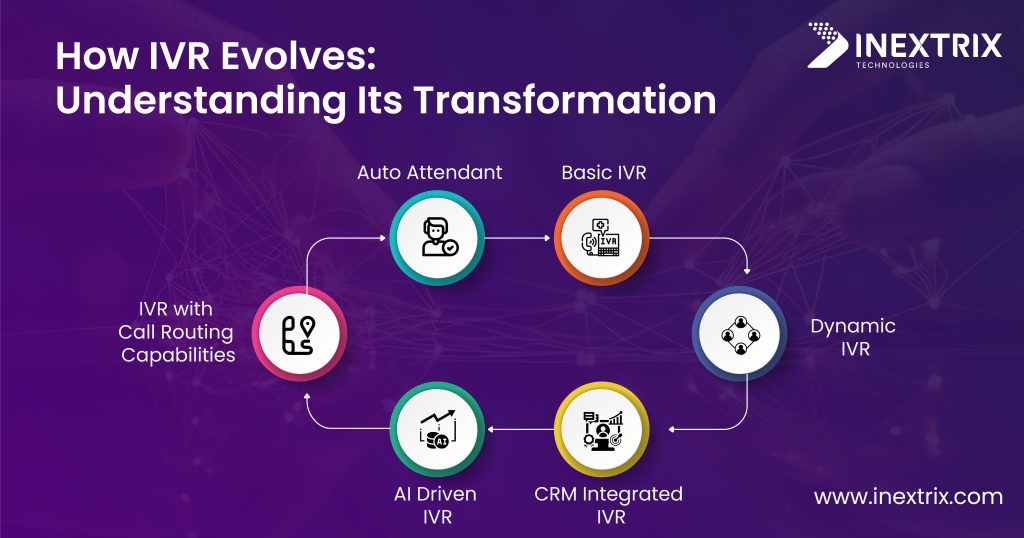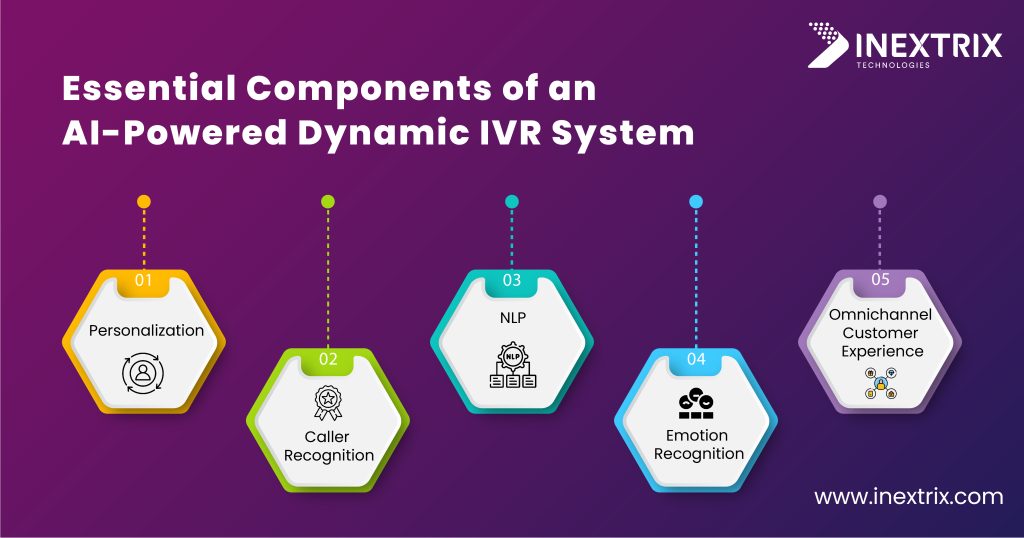IVR (Interactive Voice Response) system has been in the industry for ages. In fact, IVR is one of the fundamental communication tools. It was introduced to make business communication better and the world more connected world. Gradually, as time progressed, the companies investing in VoIP development came up with innovative IVR solutions and interesting features. To name a few, outbound IVR, dynamic IVR, CRM integrated IVR, etc. are some of the most significant innovations in this segment.
AI (Artificial Intelligence) and ML (Machine Learning) are now taking over all industry verticals. Certainly, you cannot imagine anything without AI because sooner or later, AI is going to make a significant difference in how different industries work. AI has become pivotal in augmenting communication with automation, personalization, and several other characteristics. Whether you talk about Asterisk or FreeSWITCH development, AI is becoming a substantial part of different development processes to streamline processes and build the most reliable communication tools. Moreover, artificial intelligence is also becoming part of different VoIP development solutions.
Upgrade your communication infrastructure with our tailored VoIP development solutions.
In this blog post, we will discuss the details of using AI to intensify operational efficiency and the value of a dynamic IVR system in VoIP development. To give more detailed information, we will cover all insightful details on this topic. So, without any further delays, let’s jump in and explore the role of IVR in AI driven VoIP development in detail.
1. What is an IVR System?
Interactive Voice Response System is the full form of IVR. As the name suggests, it represents an automated communication tool that lets users interact with a system that plays different voice messages. The user chooses one out of many options played by the IVR system to move to the next menu item and take a predefined action. On the other hand, the IVR system will engage the client with different and interactive voice prompts leading to completing a predefined and monotonous action.
Traditionally, companies used Asterisk development to build an IVR solution for a business. However, its popularity made it possible that even using FreeSWITCH, one can develop this system.
2. How Does IVR’s Evolve?

Fundamentally, the use of IVR was to automate the process of attending incoming calls from customers and greeting them. Moreover, businesses also took advantage of IVR to keep customers engaged with a soothing music piece set as a MoH (Music on Hold) or interactive voice menus. Gradually, several innovations took place to make this solution more competitive and intuitive. Let’s briefly understand how this system evolved.
2.1 Auto Attendant
Traditionally, IVRS only managed a single job of attending incoming calls. Ideally, the use of an IVR was to greet clients warmly every time they try to connect with a business representative. Moreover, the job of this solution was to resolve the client’s concern about listening to a busy tone all the time or most of the time.
Certainly, it met the expectations of several companies. Undoubtedly, it helps in delighting clients by greeting them immediately. Moreover, it helped in capturing their information, so customer care reps can contact them later. Furthermore, it also helped businesses to provide round-the-clock support to clients. Due to its immense contribution in customer care campaigns, it became the number one feature in all VoIP development projects.
2.2 Basic IVR
Once the auto attendant system gained popularity, the companies invested in adding interactive voice menus to engage clients. Moreover, this system lets clients take normal actions. For example, they can get answers to simple or frequently asked questions. Moreover, they can even take simple actions such as retrieving information on the due date for the bill. In short, this IVR introduced self serving features in the VoIP development industry.
2.3 IVR with Call Routing Capabilities
The next advancement in the IVR system brought call routing strategies. Certainly, call routing is part of all solutions, be it a class 5 Softswitch or a call center solution. Indeed, all businesses like to have a full-fledged solution to manage customer care campaigns. However, all businesses cannot buy a solution for that due to cost or invest in FreeSWITCH development due to lack of vision. As a result, IVR introduced a call routing feature to support basic routing within an organization. This system works phenomenally and helps small businesses to take advantage of a useful feature, call routing strategy without investing in an expensive solution or development process.
2.4 Dynamic IVR
With the gaining popularity of IVRS, dynamic IVR was introduced by the top companies. As the name suggests, it dynamically represents voice menus, unlike common ways of playing a static voice response menu. Unlike that, it chooses dynamic options to play as an IVR menu based on user interactions. This helps businesses to make IVR menus more engaging and intuitive. Moreover, it helps businesses to take multiple other actions rather than simple self serving ones.
2.5 CRM Integrated IVR
The next revolutionary introduction was a CRM integrated IVRS, which personalized the whole journey of the user. This solution can retrieve customer information from the CRM and use that to personalize voice prompts. For example, it will use the first name to address and greet the client without asking his or her name. Certainly, this is a revolutionary addition to customer care tools.
2.6 AI Driven IVR
The latest version of IVR is empowered with the capabilities of AI. It incorporates major components of artificial intelligence to make this system better, more autonomous, engaging, and beneficial. This system is the most powerful one and it can create wonders in the industry. Moreover, this system can be integrated with voice assistants and chatbots to further augment customer care campaigns and their outcomes.
3. Core Elements of an AI Driven Dynamic IVR

Essentially, an AI packed IVRS is more dynamic, personalized, smart, and autonomous. Indeed, this single system describes it all. Still, it is necessary to understand the major elements that are part of AI IVR. Please note that the development company decides to put one or more of these AI elements in your IVR solution. Therefore, your system may have one or all of these components to make your system more engaging, interesting, and client centric.
Personalization
Dynamic IVR with an integrated CRM system has already introduced this element. However, AI makes it even better with its capability of mapping past interactions and identifying patterns. Based on behavioral patterns, AI IVR can customize the voice menus and personalize them for the customer. It means depending on the past interactions and history, the client will receive the IVR menus specifically personalized for him only.
There are several other additions in the VoIP development industry along with AI packed IVR. We recommend you read our blog post covering Major Trends in the Telecom industry. This blog post shares what is new in the industry. Moreover, it gives a holistic view on how these new tools and technologies are making the telecommunication industry more robust.
Caller Recognition
The AI uses several elements like user location, customer type, and more. All this information is used by the system to dynamically represent menus to the customer. Moreover, this also customizes the call routing strategy for customers to ensure they are connected with the right agent.
NLP
NLP (Natural Language Processing) ensures that voice prompts used in the IVR system are more natural and sounds like a human is having a conversation with the client. This helps in creating a more positive experience for clients.
Emotion Recognition
If an IVR is configured to use voice responses from clients, then it can further incorporate voice emotion recognition capabilities. This helps in ensuring clients are served as per their existing mood. For example, the way of managing an angry customer will be different than managing a client with a neutral mood.
Omnichannel Customer Experience
Clients use unified communication channels. Therefore, AI driven IVRS will draw context through different interactions taking place across channels to ensure clients are served better while interacting with a voice response system.
There are several more innovations taking place in this segment by incorporating self learning and self improvement capabilities of AI engines.
4. Major Advantages of AI Packed Dynamic IVR’s

Undoubtedly, there are several advantages of using an AI packed interactive voice response solution in any business. Let’s look at three major ones.
Improve Customer Experience
Unquestionably, customers prefer self serving features due to several driving factors. Implementing AI into IVR to let them take actions autonomously will make this whole process more personalized, efficient, and engaging. Therefore, clients will find it more content. Moreover, it will help in getting first contact resolution (FCR), which will add up to customer satisfaction level. Additionally, it will streamline the customer care cycle. In short, in multiple ways, it will help in delighting clients and improve the overall experience.
Reduce Operational Expenses
With intelligent IVR systems that are empowered with the power of artificial intelligence, businesses can reduce operational expenses in multiple ways. Firstly, it will automate the process of query resolution. Secondly, it connects clients with the agent that can achieve FCR in most cases. Thirdly, it will reduce the involvement of other resources. In conclusion, AI IVR uses several approaches to cut costs for an organization that uses this tool.
Improve Resource Utilization
As AI IVR solutions automate several jobs, agents are available to use for other important tasks. For example, they can answer customer calls that cannot complete an action without agent intervention. Moreover, this IVRS will also save funds, which are available to use for other important tasks. In short, intelligent IVR saves resources, which a business can use mindfully to improve customer care and other campaigns.
5. Challenges in Implementing AI Dynamic IVR
Interestingly, there are not many challenges in implementing this powerful tool. Still, we cannot ignore discussing the major ones.
Cost
AI is an expensive technology and there is no doubt about it. Certainly, you have to invest in buying AI tools or renting AI engines to use them for your business. This demands significant investment, which often becomes the major roadblock in its adoption.
User Acceptance
Humans fear AI taking away their job and you cannot ignore the resistance due to this myth. Certainly, your team might not be that welcoming to AI packed IVR and may retaliate in one way or another. This might degrade the overall performance and customer satisfaction instead of improving it.
Lack of Learning Models
AI tools are completely dependent on learning models. Thus, to work efficiently, they need a lot of learning models and use cases. Small businesses or unique business models often lack this data. This may result in inaccurate systems. Therefore, the system would perform poorly.
Concluding Note
IVR addresses the challenges and customer demands that businesses face due to evolution in the technology landscape. Moreover, IVR helps in meeting customer expectations for prompt and personalized care. As a result, businesses are increasingly adopting these self-serving IVR systems to remain competitive.
IVRs facilitate accelerated and efficient service delivery, minimize customer wait times, and boost overall satisfaction. Additionally, these systems can contribute to enhanced customer data collection and analysis by tracking customer interactions, providing businesses with insights into customer behavior and preferences. This insight can then be utilized by product management to improve products and by marketers to develop more effective marketing strategies.
In conclusion, there are several amazing advantages of using an IVRS. Therefore, several evolutions took place for this solution. From simple Asterisk development to building a basic auto attendant system to an AI driven IVRS, the whole landscape of self serving tools have been revolutionized. AI packed IVR has augmented the process of managing incoming calls, customer concerns, and customer care campaigns in a personalized manner. Moreover, they offer several advantages that make your business competitive and future-proof. Therefore, more and more businesses are in quest of adopting this powerful self serving tool for their clients.
We can help you build the most engaging AI IVR system with our expert development services. To learn more about our VoIP development service to build an AI packed IVRS, contact us.


